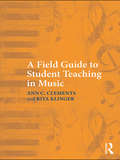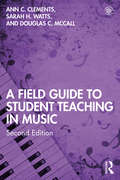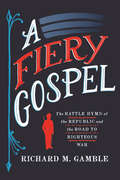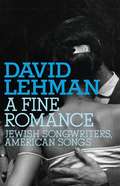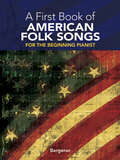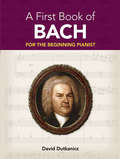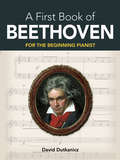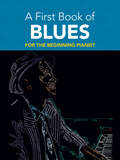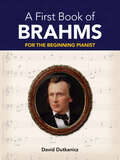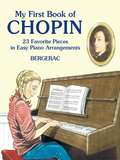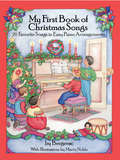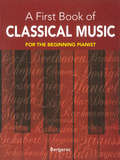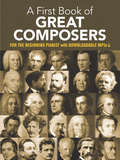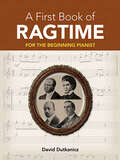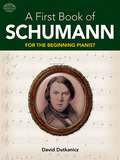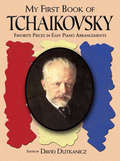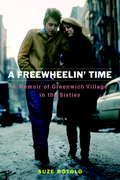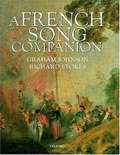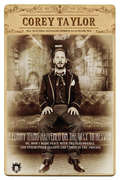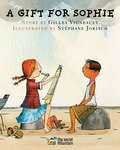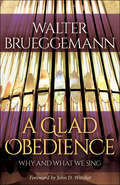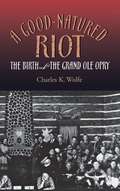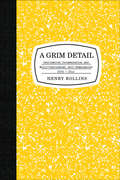- Table View
- List View
A Field Guide to Student Teaching in Music
by Rita Klinger Ann C. ClementsA Field Guide to Student Teaching in Music is a practical guide focused on the link between music education coursework and the field-based aspects of the student teaching experience. It addresses general topics that are common to all music placements, as well as those topics that are of specific interest to the general, choral, and instrumental music classrooms. This text builds on theoretical materials typically covered in music methods courses, yet it is not specific to any one particular teaching pedagogy, making it flexible enough for use in a variety of music teaching settings. It will guide students through the student teaching process as they make the transition from student to music educator.
A Field Guide to Student Teaching in Music
by Ann C. Clements Sarah H. Watts Douglas C. McCallA Field Guide to Student Teaching in Music, Second Edition, serves as a practical guide for the music education student, one that recognizes the importance of effective coursework while addressing the unique field-based aspects of the music classroom. Student teaching in music is a singular experience, presenting challenges beyond those encountered in general education classroom settings: educators must plan for singing and movement, performances and rehearsals, intensive parent involvement, uniforms, community outreach, and much more. This guide explores such topics common to all music placements as well as those specific to general, choral, and instrumental music classrooms, building on theoretical materials often covered in music methods courses and yet not beholden to any one pedagogy, thus allowing for a dynamic and flexible approach for various classroom settings. New to the second edition: Companion website featuring downloadable worksheets, résumé support, a cooperating teacher guide, and more: www.musicstudentteaching.com A new chapter on the transition from student to student teacher Expanded discussions on the interview process, including mock interviews, interviewing techniques, and online interview prep Updated content throughout to reflect current practices in the field. Leading readers through the transition from student to teacher, A Field Guide to Student Teaching in Music, Second Edition, represents a necessary update to the first edition text published a decade ago, an indispensable resource that provides the insights and skillsets students need to launch successful careers as music educators.
A Fiery Gospel: The Battle Hymn of the Republic and the Road to Righteous War (Religion and American Public Life)
by Richard M. GambleSince its composition in Washington's Willard Hotel in 1861, Julia Ward Howe's "Battle Hymn of the Republic" has been used to make America and its wars sacred. Few Americans reflect on its violent and redemptive imagery, drawn freely from prophetic passages of the Old and New Testaments, and fewer still think about the implications of that apocalyptic language for how Americans interpret who they are and what they owe the world. In A Fiery Gospel, Richard M. Gamble describes how this camp-meeting tune, paired with Howe's evocative lyrics, became one of the most effective instruments of religious nationalism. He takes the reader back to the song's origins during the Civil War, and reveals how those political and military circumstances launched the song's incredible career in American public life. Gamble deftly considers the idea behind the song—humming the tune, reading the music for us—all while reveling in the multiplicity of meanings of and uses to which Howe's lyrics have been put. "The Battle Hymn of the Republic" has been versatile enough to match the needs of Civil Rights activists and conservative nationalists, war hawks and peaceniks, as well as Europeans and Americans. This varied career shows readers much about the shifting shape of American righteousness. Yet it is, argues Gamble, the creator of the song herself—her Abolitionist household, Unitarian theology, and Romantic and nationalist sensibilities—that is the true conductor of this most American of war songs. A Fiery Gospel depicts most vividly the surprising genealogy of "The Battle Hymn of the Republic," and its sure and certain position as a cultural piece in the uncertain amalgam that was and is American civil religion.
A Fine Romance: Jewish Songwriters, American Songs
by David LehmanWith a poet's eye for language and nuance, Lehman takes a personal journey into the past of American music, showing how the songs that we view as quintessentially American were almost all written by Jews, many of them immigrants. Recounting the stories behind numerous songs and shows, the author explains how Jewish songsmiths combined their native plaintiveness and wit with Black blues to create a distinctively American musical form. With analytical skill, wit, and exuberance, Lehman helps readers understand how natural it is that Wizard of Oz composer Harold Arlen was the son of a cantor who incorporated "Over the Rainbow" into his Sabbath liturgy Annotation c2010 Book News, Inc. , Portland, OR (booknews. com)
A First Book of American Folk Songs: 25 Favorite Pieces in Easy Piano Arrangements (Dover Classical Piano Music For Beginners)
by BergeracYoung pianists and their teachers will welcome this treasury of favorites in musically attractive and pedagogically sound arrangements for beginners. Bergerac has written exclusively for young pianists since 1967, including original music and many easy arrangements of folk materials. His expert settings explore a full and satisfying piano sound within the natural capabilities of the beginning performer.The songs in this varied collection -- arranged in their approximate order of difficulty -- are presented in large, clear, easy-to-read musical notation, and are accompanied by delightful illustrations suggested by this charming music. The songs included are Amazing Grace (in two arrangements); I've Been Working on the Railroad; As We Go 'Round the Mulberry Bush; Maryland, My Maryland!; Aura Lea; The Old Chisholm Trail; Billy Boy; Polly-Wolly-Doodle; Black Is the Color of My True Love's Hair; Pop Goes the Weasel!; Blow the Man Down!; Short'nin' Bread; Blue-Tail Fly (Jimmy Crack Corn); Skip to My Lou; Buffalo Gals; Sweet Betsy from Pike; Deep River; Thanksgiving Prayer; Down by the Riverside (We Gather Together); The Farmer in the Dell; Turkey in the Straw; The Gift to Be Simple; Yankee Doodle Dandy; Go Down, Moses (Let My People Go); and The Yellow Rose of Texas.
A First Book of Bach: For The Beginning Pianist with Downloadable MP3s (Dover Classical Piano Music For Beginners)
by David DutkaniczThese special arrangements offer beginning pianists the pleasure and satisfaction of playing Bach. Students of all ages will delight in these easy, pedagogical piano arrangements of familiar melodies such as "Jesu, Joy of Man's Desiring," "Sheep May Safely Graze," and the haunting opening from the "Toccata and Fugue in D Minor."Arranged in order of approximate difficulty, 26 selections include "Air on a G String," "Wachet Auf," and highlights from the Brandenburg Concertos, the Goldberg Variations, and the Inventions. Additional features include a generous assortment of menuets, gavottes, bourrées, and other fun-to-play pieces.
A First Book of Beethoven: 24 Arrangements for the Beginning Pianist with Downloadable MP3s
by David DutkaniczSpecially arranged and simplified, these pieces offer beginners the pleasure and satisfaction of playing Beethoven. Students and teachers alike will delight in such popular melodies as "Für Elise," "Ode to Joy," and the haunting opening of the Moonlight Sonata.A First Book of Beethoven features 24 selections, including "Romance in F," "Turkish March," "Minuet in G," and "Bagatelle in G Minor." It includes excerpts from the sonatas--such as the opening of the 2nd movement of Sonata No. 14, the "Adagio" from Piano Sonata No. 5, and "Adagio Cantabile" from Sonata No. 8--as well as highlights from the symphonies.Along with the twenty-four piano arrangements, this collection includes a free MP3 download for every piece, which will help beginning pianists develop an ear for the melodies. The MP3s may be downloaded individually or collectively.
A First Book of Blues: 16 Arrangements for the Beginning Pianist (Dover Classical Piano Music For Beginners)
by David DutkaniczWith these easy-to-play renditions, beginning pianists of all ages can enjoy one of America's most celebrated art forms. Sixteen popular blues melodies include traditional songs such as "St. James Infirmary" and "Careless Love" as well as several numbers by blues giants Jelly Roll Morton and W. C. Handy, including "St. Louis Blues," "Joe Turner Blues," and "The Hesitating Blues." Students, teachers, and other pianists will find these arrangements much simpler and more melodic than other versions. The selections include suggestions for fingering and are arranged in order of increasing difficulty. Introductory material by editor David Dutkanicz offers helpful explanations of the melodic and rhythmic theory behind the blues.
A First Book of Brahms: 26 Arrangements for the Beginning Pianist (Dover Classical Piano Music For Beginners)
by David DutkaniczSuitable for beginning pianists of all ages, this volume features 26 simplified versions of longer pieces by the great Johannes Brahms arranged in order of increasing difficulty. Selections include the famous "Lullaby" as well as the theme from "Academic Festival Overture" and "Hungarian Dance No. 5." Additional melodies include themes from the composer's quintet and concertos for piano, "Variations on a Theme by Haydn," and other pieces.
A First Book of Chopin: for the Beginning Pianist with Downloadable MP3s (Dover Music for Piano)
by BergeracBeginning pianists and their teachers will love this compilation of immortal music by Frédéric Chopin. Fun-to-play, pedagogically sound arrangements include the theme from the "Raindrop" Prelude, "Minute" Waltz, the charming Lullaby, and melodic highlights from the most familiar preludes, mazurkas, waltzes, impromptus, and etudes.Each piece is accompanied by informal notes that share insights into Chopin's life and the unique features of his music. From the lyrical Fantaisie-impromptu and "Butterfly" Etude to the brilliant strains of the "Military" Polonaise and "Heroic" Polonaise, these arrangements of 23 of the composer's best-loved pieces will prove welcome additions to any beginning pianist's repertoire. Plus, bonus MP3 downloads are included for each song to make practicing even easier!
A First Book of Christmas Songs: 20 Favorite Songs in Easy Piano Arrangements
by BergeracBeginning pianists will love playing the music of Christmas with this new volume of holiday songs in musically attractive, pedagogically sound, and fun-to-play arrangements. These expert settings explore a full and satisfying piano sound within the natural capabilities of the novice performer. Twenty holiday favorites include Silent Night; O, Come All Ye Faithful; O Little Town of Bethlehem; Jingle Bells; Deck the Halls; O Christmas Tree; and more.Delightful illustrations add a festive note to this modestly priced collection, which will be welcomed by beginning pianists of all ages.
A First Book of Classical Music: 29 Themes by Beethoven, Mozart, Chopin and Other Great Composers in Easy Piano Arrangements
by BergeracThese fun-to-play, pedagogically sound piano arrangements include themes from Beethoven's Ode to Joy and Bach's Sheep May Safely Graze, along with such favorites as Schumann's Träumerei, Brahms' Hungarian Dance No. 5, Tchaikovsky's Marche Slave, and Wagner's Song to the Evening Star. Additional composers include Chopin, Grieg, Handel, Vivaldi, Liszt, Haydn, and many others.Along with the 24 piano arrangements, this collection includes a free MP3 download for every piece, which will help beginning pianists develop an ear for the melodies. The MP3s may be downloaded individually or collectively.
A First Book of Great Composers: for the Beginning Pianist with Downloadable MP3s (Dover Music for Piano)
by BergeracThis new gathering of the world's greatest classical themes follows Bergerac's highly successful My First Book of Classical Music. Here are ever-popular themes from the symphonies, concertos, and operas of such masters as Bach, Beethoven, Brahms, Chopin, Mozart, Haydn, Tchaikovsky, Verdi, and many others, presented in easy-to-play formats for children and beginners of any age. This collection includes a free MP3 download for every piece, which will help beginning pianists develop an ear for the melodies. The MP3s may be downloaded individually or collectively.
A First Book of Ragtime: 24 Arrangements for the Beginning Pianist (Dover Classical Piano Music For Beginners)
by David DutkaniczThis compilation of easy-to-play ragtime favorites features 24 rollicking melodies by "The Big Three" of ragtime--Scott Joplin, James Scott, and Joseph Lamb--plus pieces by Eubie Blake, Tom Turpin, and other artists. Popular tunes include "Maple Leaf Rag," "The Entertainer," and "Tiger Rag." Novices of all ages will delight in these simplified arrangements of carefully selected pieces. The editor provides suggested fingerings and comments on each piece that include background on the composers and tips for performance.
A First Book of Schumann: 32 Arrangements for the Beginning Pianist (Dover Music for Piano)
by David DutkaniczThis beginner's piano book spotlights the music of one of the Romantic movement's most influential composers, Robert Schumann. Its easy-to-play renditions of Schumann's beloved works progressively increase in difficulty and are accessible to novices of all ages. Contents include selections from Forest Scenes, Scenes from Childhood, Album for the Young, and Carnaval, a collection of short pieces representing revelers at a masked ball. Selections include "Traumerei," "Happy Farmer," "Papillons," and other melodies for solo piano.
A First Book of Tchaikovsky: for the Beginning Pianist with Downloadable MP3s (Dover Music for Piano)
by David DutkaniczThis collection of effortless arrangements allows beginning pianists to experience the pleasure of playing favorite Tchaikovsky compositions. Offering an inspiring mix of tempos and moods, the twenty-one simplified compositions include themes from The Nutcracker, Romeo and Juliet, Swan Lake, Sleeping Beauty, and other popular works. My First Book of Tchaikovsky is a wonderful introduction to the nineteenth-century master -- and a unique way for novices to expand their repertoires! Additional Tchaikovsky treasures include 1812 Overture, Symphonies Nos. 5 and 6, March Slav, and Hurdy-Gurdy.
A Freewheelin' Time: A Memoir of Greenwich Village in the Sixties
by Suze RotoloRotolo, who was romantically involved with Bob Dylan from 1961 to 1964 (she's the girl on the cover of his debut album), has written this memoir of the rise of the folk music movement in Greenwich Village from a firsthand perspective. Exhibiting a writing style that is succinct yet impassioned, she vividly recreates that period in history while recounting her own growing political awareness, and explains how folk music eventually led her to a life of activism (she became involved in the Civil Rights Movement). Fans of Bob Dylan and folk music in general should enjoy this volume. Annotation ©2008 Book News, Inc. , Portland, OR (booknews. com)
A French Song Companion
by Graham Johnson Richard StokesThis is the most comprehensive book of French mélodie (French art-song) in any language. Graham Johnson, a noted authority on song, provides repertoire guides to the work of some 150 composers who have written French vocal music. There are major articles on such figures as Fauré, Duparc, Debussy, Ravel, and Poulenc; substantial articles on Bizet, Chabrier, Gounod, Chausson, Hahn, and Satie; and reassessments of such composers as Massenet, Koechlin, and Leguerney. The biographical articles are supplemented by the song translations of Richard Stokes, some 700 in all, and a veritable treasury of great French poetry from the fifteenth to the twentieth centuries. These are indispensable to music lovers, concert-goers, and professional singers and their accompanists. Graham Johnson is one of the most distinguished vocal accompanists of our time. Recital appearances with many great singers--from Schwarzkopf and De los Angeles to Margaret Price and Christine Schäfer, from Peter Pears to Anthony Rolfe-Johnson, Peter Schreier, and Ian Bostridge, from François Le Roux to Thomas Hampson and Matthias Goerne--have been supplemented by a prodigious recording career: the complete Schubert Lieder on 37 CDs for Hyperion, with a similar exhaustive Schumann project already underway; an ongoing edition of French song recordings, also for Hyperion; numerous recordings of English song composers (recently Britten and John Ireland); duet recitals with Felicity Lott and Ann Murray (on EMI); and discs of songs by such composers as Dvorák, Janácek, Martinu, and Musorgsky. Richard Stokes, the translator of the songs, teaches languages at Westminster School, London, coaches singers in the interpretation of Lieder, and gives frequent lectures on song composers. He is the co-author of books on German and Spanish song (The Fischer-Dieskau Book of Lieder and The Spanish Song Companion) and has just published J. S. Bach--The Complete Church and Secular Cantatas (Long Barn Books). Below each line of French is a line of English translation. In addition, DAISY markup sets each composer at level 1 and each song at level 2, facilitating navigation through the book. The web site Hyperion-Records.co.uk contains pdf files of the many booklets of songs and commentary produced by Graham Johnson and Richard Stokes, free for downloading, including the complete Schubert songs and many of the song composers listed above.
A Funny Thing Happened on the Way to Heaven: (Or, How I Made Peace with the Paranormal and Stigmatized Zealots and Cynics in the Process)
by Corey TaylorIn this book, Corey Taylor undertakes something never before attempted in the history of rock superstardom: he takes you with him as he journeys undercover through various ghostbusting groups who do their best to gather information and evidence about the existence of spirits. Some are more credible than others, and, frankly, some are completely insane, but all are observed with appropriate seriousness as Taylor attempts to better understand some of the spooky things that have happened to him in his life, especially that night at the Cold House.But that's not all, folks. Taylor once again gives you a behind-the-scenes tour of his crazy life and the many beyond-the-grave events he's encountered. (You'll be shocked how often Slipknot has been invaded by the supernatural.) Taylor also touches on his religious background and how it led him to believe in much more than the Man in the Sky.
A Gift for Sophie
by Gilles VigneaultWinner of:Parents' Choice Recommended Award In this touching, poetic story set by the seaside, Old Man Tom teaches Sophie and Emilio the importance of seeing the world through their hearts. Presenting children with profound messages about friendship and gifts as well as old age and continuity, the book and accompanying CD offers a heartwarming perspective for the whole family. In addition to a production of the narrated story, the CD includes nine songs ranging from "A Friend That I Like" and "It's in the Nature of Things" to "I Have a Nest Full" and "The Old Man's House."
A Gift of Hope: The Tony Melendez Story
by Mel White Tony MelendezFrom the Publisher: The inspiring story of a young thalidomide victim and talented musician who has gained international recognition. Wonderful reading for anyone--especially those facing seemingly insurmountable difficulties. ... This is a beautifully, and positively, written autobiography. Melendez neither downplays his and his family's struggles resulting from his lack of arms, nor does he whine about them. Writing about his father, "Still, he knew that only in America would he find the kind of medical treatment I needed, so he put his own dreams aside and began to dream for me. He was young, strong, and determined to provide for each of us-but especially, I believe, for me. Imagine his growing frustration as he tried to support us on the minimum wage jobs that he could find. And there was no extra time or money to train in another field. [In Nicaragua, he was educated and accomplished in the fields of agriculture and animal husbandry.] Instead, he found himself in a huge pool of cheap labor as more and more unskilled young people migrated to America."
A Glad Obedience: Why and What We Sing
by Walter BrueggemannThe Christian practice of hymn singing, says renowned biblical scholar Walter Brueggemann, is a countercultural act. It marks the Christian community as different from an unforgiving and often ungrateful culture. It is also, he adds, an "absurd enterprise” in the midst of the hyper-busy, market-driven society that surrounds us. In this helpful and engaging volume, Brueggemann discusses both why we sing and what we sing. The first part of the book examines the Psalms and what they can teach us about the reasons that corporate song is a part of the Christian tradition. The second part looks at fifteen popular hymns, including classic and contemporary ones such as “Blest Be the Ties That Binds,” “God's Eye Is on the Sparrow,” “Once to Every Man and Nation,” “Someone Asked the Question,” and “We Are Marching in the Light of God,” and the reasons why they have caught our imagination.
A Good-Natured Riot: The Birth of the Grand Ole Opry (Co-published with the Country Music Foundation Press)
by Charles K. WolfeWinner of the Ralph J. Gleason Music Book AwardWinner of the ASCAP Deems Taylor AwardOn November 28, 1925, a white-bearded man sat before one of Nashville radio station WSM's newfangled carbon microphones to play a few old-time fiddle tunes. Uncle Jimmy Thompson played on the air for an hour that night, and throughout the region listeners at their old crystal sets suddenly perked up. Back in Nashville the response at the offices of National Life Insurance Company, which owned radio station WSM ("We Shield Millions"), was dramatic; phone calls and telegrams poured into the station, many of them making special requests. It was not long before station manager George D. Hay was besieged by pickers and fiddlers of every variety, as well as hoedown bands, singers, and comedians—all wanting their shot at the Saturday night airwaves. "We soon had a good-natured riot on our hands," Hay later recalled. And, thus, the Opry was born.Or so the story goes. In truth, the birth of the Opry was a far more complicated event than even Hay, "the solemn old Judge," remembered. The veteran performers of that era are all gone now, but since the 1970s pioneering country music historian Charles K. Wolfe has spent countless hours recording the oral history of the principals and their families and mining archival materials from the Country Music Foundation and elsewhere to understand just what those early days were like. The story that he has reconstructed is fascinating. Both a detailed history and a group biography of the Opry's early years, A Good-Natured Riot provides the first comprehensive and thoroughly researched account of the personalities, the music, and the social and cultural conditions that were such fertile ground for the growth of a radio show that was to become an essential part of American culture.Wolfe traces the unsure beginnings of the Opry through its many incarnations, through cast tours of the South, the Great Depression, commercial sponsorship by companies like Prince Albert Tobacco, and the first national radio linkups. He gives colorful and engaging portraits of the motley assembly of the first Opry casts—amateurs from the hills and valleys surrounding Nashville, like harmonica player Dr. Humphrey Bate ("Dean of the Opry") and fiddler Sid Harkreader, virtuoso string bands like the Dixieliners, colorful hoedown bands like the Gully Jumpers and the Fruit Jar Drinkers, the important African American performer DeFord Bailey, vaudeville acts and comedians like Lasses and Honey, through more professional groups such as the Vagabonds, the Delmore Brothers, Bill Monroe and the Blue Grass Boys, and perennial favorite Roy Acuff and his Smoky Mountain Boys.With dozens of wonderful photographs and a complete roster of every performer and performance of these early Opry years, A Good-Natured Riot gives a full and authoritative portrayal of the colorful beginnings of WSM's barn dance program up to 1940, by which time the Grand Ole Opry had found its national audience and was poised to become the legendary institution that it remains to this day.
A Good-Natured Riot: The Birth of the Grand Ole Opry (Co-published with the Country Music Foundation Press)
by Charles K. WolfeWinner of the Ralph J. Gleason Music Book AwardWinner of the ASCAP Deems Taylor Award On November 28, 1925, a white-bearded man sat before one of Nashville radio station WSM's newfangled carbon microphones to play a few old-time fiddle tunes. Uncle Jimmy Thompson played on the air for an hour that night, and throughout the region listeners at their old crystal sets suddenly perked up. Back in Nashville the response at the offices of National Life Insurance Company, which owned radio station WSM ("We Shield Millions"), was dramatic; phone calls and telegrams poured into the station, many of them making special requests. It was not long before station manager George D. Hay was besieged by pickers and fiddlers of every variety, as well as hoedown bands, singers, and comedians--all wanting their shot at the Saturday night airwaves. "We soon had a good-natured riot on our hands," Hay later recalled. And, thus, the Opry was born. Or so the story goes. In truth, the birth of the Opry was a far more complicated event than even Hay, "the solemn old Judge," remembered. The veteran performers of that era are all gone now, but since the 1970s pioneering country music historian Charles K. Wolfe has spent countless hours recording the oral history of the principals and their families and mining archival materials from the Country Music Foundation and elsewhere to understand just what those early days were like. The story that he has reconstructed is fascinating. Both a detailed history and a group biography of the Opry's early years, A Good-Natured Riot provides the first comprehensive and thoroughly researched account of the personalities, the music, and the social and cultural conditions that were such fertile ground for the growth of a radio show that was to become an essential part of American culture. Wolfe traces the unsure beginnings of the Opry through its many incarnations, through cast tours of the South, the Great Depression, commercial sponsorship by companies like Prince Albert Tobacco, and the first national radio linkups. He gives colorful and engaging portraits of the motley assembly of the first Opry casts--amateurs from the hills and valleys surrounding Nashville, like harmonica player Dr. Humphrey Bate ("Dean of the Opry") and fiddler Sid Harkreader, virtuoso string bands like the Dixieliners, colorful hoedown bands like the Gully Jumpers and the Fruit Jar Drinkers, the important African American performer DeFord Bailey, vaudeville acts and comedians like Lasses and Honey, through more professional groups such as the Vagabonds, the Delmore Brothers, Bill Monroe and the Blue Grass Boys, and perennial favorite Roy Acuff and his Smoky Mountain Boys. With dozens of wonderful photographs and a complete roster of every performer and performance of these early Opry years, A Good-Natured Riot gives a full and authoritative portrayal of the colorful beginnings of WSM's barn dance program up to 1940, by which time the Grand Ole Opry had found its national audience and was poised to become the legendary institution that it remains to this day.
A Grim Detail
by Henry RollinsA Grim Detail shoulders the anchor, drags it onward from the end of 2008 and then hurls to the ground in2010. A world tour, two documentaries and journeys that include North Korea, South Sudan, Saudi Arabia, Mongolia and many others are contained herein."Oh no, not another one!" was said or implied by almost everyone involved in the making of this book.Actually, no-it was all of us. After three on and off years of proofreading and editing, A Grim Detail became the kid who no one wanted to play with.Don't laugh. I was that kid, and I am this book, well, you know what I mean.But then, in the early days of 2014, work on A Grim Detail concluded. The relief was total,the contempt, incalculable, the ridicule to come, too painful to imagine.Now, the damn thing is all yours. Have a good cringe and thank you for everything.--Henry Rollins
